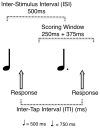The relationship between the age of onset of musical training and rhythm synchronization performance: validation of sensitive period effects
- PMID: 24348323
- PMCID: PMC3843222
- DOI: 10.3389/fnins.2013.00227
The relationship between the age of onset of musical training and rhythm synchronization performance: validation of sensitive period effects
Abstract
A sensitive period associated with musical training has been proposed, suggesting the influence of musical training on the brain and behavior is strongest during the early years of childhood. Experiments from our laboratory have directly tested the sensitive period hypothesis for musical training by comparing musicians who began their training prior to age seven with those who began their training after age seven, while matching the two groups in terms of musical experience (Watanabe et al., 2007; Bailey and Penhune, 2010, 2012). Using this matching paradigm, the early-trained groups have demonstrated enhanced sensorimotor synchronization skills and associated differences in brain structure (Bailey et al., 2013; Steele et al., 2013). The current study takes a different approach to investigating the sensitive period hypothesis for musical training by examining a single large group of unmatched musicians (N = 77) and exploring the relationship between age of onset of musical training as a continuous variable and performance on the Rhythm Synchronization Task (RST), a previously used auditory-motor RST. Interestingly, age of onset was correlated with task performance for those who began training earlier, however, no such relationship was observed among those who began training in their later childhood years. In addition, years of formal training showed a similar pattern. However, individual working memory scores were predictive of task performance, regardless of age of onset of musical training. Overall, these results support the sensitive period hypothesis for musical training and suggest a non-linear relationship between age of onset of musical training and auditory-motor rhythm synchronization abilities, such that a relationship exists early in childhood but then plateaus later on in development, similar to maturational growth trajectories of brain regions implicated in playing music.
Keywords: brain development; early training; musical training; sensitive period; working memory.
Figures






References
LinkOut - more resources
Full Text Sources
Other Literature Sources

